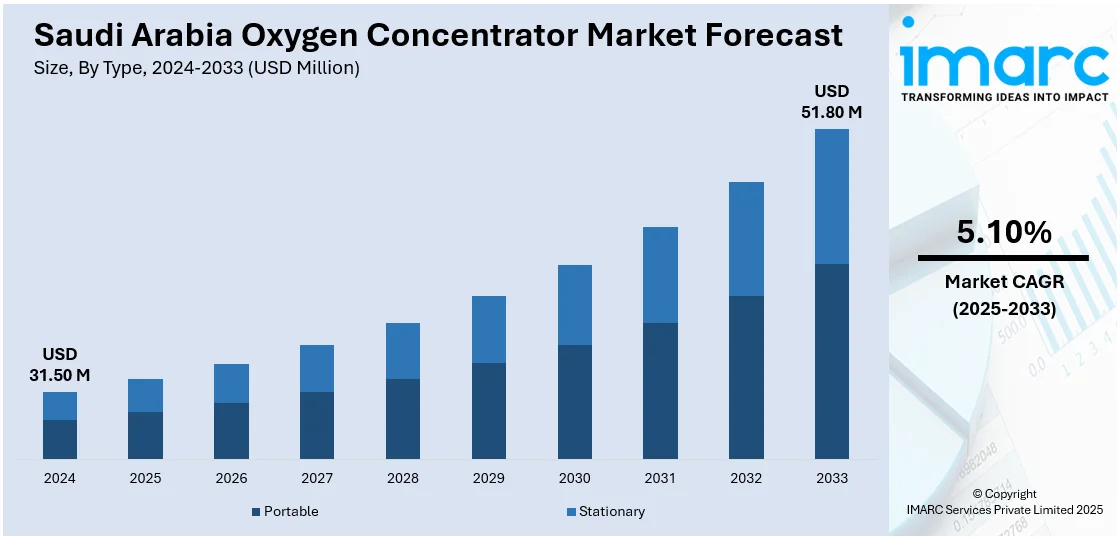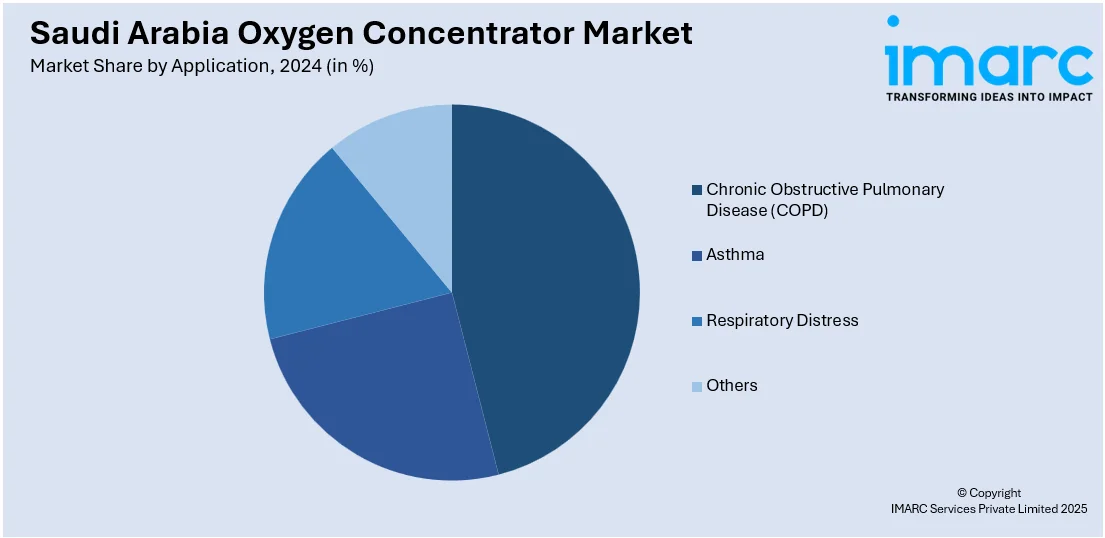
Saudi Arabia Oxygen Concentrator Market Size, Share, Trends and Forecast by Type, Technology, Application, End User, and Region, 2025-2033
Saudi Arabia Oxygen Concentrator Market Overview:
The Saudi Arabia oxygen concentrator market size reached USD 31.50 Million in 2024. Looking forward, IMARC Group expects the market to reach USD 51.80 Million by 2033, exhibiting a growth rate (CAGR) of 5.10% during 2025-2033. The market is experiencing steady growth, driven by the increasing demand for healthcare services, aging population, and rising chronic respiratory diseases. Technological advancements in oxygen concentrator devices, along with government initiatives to enhance healthcare infrastructure and the demand for both portable and stationary oxygen concentrators is contributing to the overall Saudi Arabia oxygen concentrator market share.
|
Report Attribute
|
Key Statistics
|
|---|---|
|
Base Year
|
2024 |
|
Forecast Years
|
2025-2033
|
|
Historical Years
|
2019-2024
|
| Market Size in 2024 | USD 31.50 Million |
| Market Forecast in 2033 | USD 51.80 Million |
| Market Growth Rate 2025-2033 | 5.10% |
Saudi Arabia Oxygen Concentrator Market Trends:
Government Healthcare Initiatives
Government healthcare initiatives in Saudi Arabia are contributing significantly to growing the market for oxygen concentrators. The government has been investing heavily in healthcare facilities with a view to enhancing access to quality health care, especially for patients suffering from chronic diseases such as respiratory disorders. According to the data published by ITA, Saudi Arabia allocates $50.4 billion, 16.96% of its 2023 budget, for healthcare, prioritizing privatization. Key players include the Ministry of Health, NUPCO, SFDA, and the Health Holding Company. Such investments involve the construction of world-class hospitals, clinics, and home healthcare, which increase the availability and accessibility of oxygen therapy. Moreover, policies promoting the alleviation of the healthcare burden of respiratory diseases are prompting the adoption of medical devices like oxygen concentrators. For instance, the enactment of subsidies and insurance coverage of oxygen concentrator purchases has provided patients with financial relief. These efforts, coupled with efforts to enhance the general healthcare system, guarantee greater availability of life-saving medical equipment, thereby driving the growth of the Saudi Arabia oxygen concentrator market.

Increasing Prevalence of Respiratory Diseases
The growing incidence of chronic respiratory diseases, such as Chronic Obstructive Pulmonary Disease (COPD) and asthma, is a key factor driving the demand for oxygen concentrators in Saudi Arabia. A recent study in the Aseer region of Southwestern Saudi Arabia found a 19.2% prevalence rate of bronchial asthma. Other research indicates a significant prevalence of asthma nationwide, emphasizing the importance of using the European Community Respiratory Health Survey (ECRHS) criteria to assess asthma symptoms in adults. Respiratory conditions are becoming more common due to factors like air pollution, smoking, and lifestyle changes, increasing the need for long-term respiratory support. As the number of patients requiring oxygen therapy grows, the demand for oxygen concentrators both portable and stationary has surged. This trend is further amplified by the country's healthcare system improvements, which make it easier for individuals to access the necessary equipment. Increased awareness about the importance of early diagnosis and treatment for respiratory conditions is also driving this demand. With more patients seeking home-based oxygen therapy solutions, the market for oxygen concentrators continues to expand, contributing significantly to the Saudi Arabia oxygen therapy market growth.
Saudi Arabia Oxygen Concentrator Market Segmentation:
IMARC Group provides an analysis of the key trends in each segment of the market, along with forecasts at the country and regional levels for 2025-2033. Our report has categorized the market based on type, technology, application, and end user.
Type Insights:
- Portable
- Stationary
The report has provided a detailed breakup and analysis of the market based on the type. This includes portable and stationary.
Technology Insights:
- Continuous Flow
- Pulse Flow
A detailed breakup and analysis of the market based on the technology have also been provided in the report. This includes continuous flow and pulse flow.
Application Insights:

- Chronic Obstructive Pulmonary Disease (COPD)
- Asthma
- Respiratory Distress
- Others
A detailed breakup and analysis of the market based on the application have also been provided in the report. This includes chronic obstructive pulmonary disease (COPD), asthma, respiratory distress, and others.
End User Insights:
- Hospitals and Clinics
- Home Care Settings
- Ambulatory Surgical Centers and Physician Offices
A detailed breakup and analysis of the market based on the end user have also been provided in the report. This includes hospitals and clinics, home care settings, and ambulatory surgical centers and physician offices.
Regional Insights:
- Northern and Central Region
- Western Region
- Eastern Region
- Southern Region
The report has also provided a comprehensive analysis of all the major regional markets, which include Northern and Central Region, Western Region, Eastern Region, and Southern Region.
Competitive Landscape:
The market research report has also provided a comprehensive analysis of the competitive landscape. Competitive analysis such as market structure, key player positioning, top winning strategies, competitive dashboard, and company evaluation quadrant has been covered in the report. Also, detailed profiles of all major companies have been provided.
Saudi Arabia Oxygen Concentrator Market Report Coverage:
| Report Features | Details |
|---|---|
| Base Year of the Analysis | 2024 |
| Historical Period | 2019-2024 |
| Forecast Period | 2025-2033 |
| Units | Million USD |
| Scope of the Report |
Exploration of Historical Trends and Market Outlook, Industry Catalysts and Challenges, Segment-Wise Historical and Future Market Assessment:
|
| Types Covered | Portable, Stationary |
| Technologies Covered | Continuous Flow, Pulse Flow |
| Applications Covered | Chronic Obstructive Pulmonary Disease (COPD), Asthma, Respiratory Distress, Others |
| End Users Covered | Hospitals and Clinics, Home Care Settings, Ambulatory Surgical Centers and Physician Offices |
| Regions Covered | Northern and Central Region, Western Region, Eastern Region, Southern Region |
| Customization Scope | 10% Free Customization |
| Post-Sale Analyst Support | 10-12 Weeks |
| Delivery Format | PDF and Excel through Email (We can also provide the editable version of the report in PPT/Word format on special request) |
Key Questions Answered in This Report:
- How has the Saudi Arabia oxygen concentrator market performed so far and how will it perform in the coming years?
- What is the breakup of the Saudi Arabia oxygen concentrator market on the basis of type?
- What is the breakup of the Saudi Arabia oxygen concentrator market on the basis of technology?
- What is the breakup of the Saudi Arabia oxygen concentrator market on the basis of application?
- What is the breakup of the Saudi Arabia oxygen concentrator market on the basis of end user?
- What is the breakup of the Saudi Arabia oxygen concentrator market on the basis of region?
- What are the various stages in the value chain of the Saudi Arabia oxygen concentrator market?
- What are the key driving factors and challenges in the Saudi Arabia oxygen concentrator market?
- What is the structure of the Saudi Arabia oxygen concentrator market and who are the key players?
- What is the degree of competition in the Saudi Arabia oxygen concentrator market?
Key Benefits for Stakeholders:
- IMARC’s industry report offers a comprehensive quantitative analysis of various market segments, historical and current market trends, market forecasts, and dynamics of the Saudi Arabia oxygen concentrator market from 2019-2033.
- The research report provides the latest information on the market drivers, challenges, and opportunities in the Saudi Arabia oxygen concentrator market.
- Porter's five forces analysis assist stakeholders in assessing the impact of new entrants, competitive rivalry, supplier power, buyer power, and the threat of substitution. It helps stakeholders to analyze the level of competition within the Saudi Arabia oxygen concentrator industry and its attractiveness.
- Competitive landscape allows stakeholders to understand their competitive environment and provides an insight into the current positions of key players in the market.
Need more help?
- Speak to our experienced analysts for insights on the current market scenarios.
- Include additional segments and countries to customize the report as per your requirement.
- Gain an unparalleled competitive advantage in your domain by understanding how to utilize the report and positively impacting your operations and revenue.
- For further assistance, please connect with our analysts.
 Request Customization
Request Customization
 Speak to an Analyst
Speak to an Analyst
 Request Brochure
Request Brochure
 Inquire Before Buying
Inquire Before Buying




.webp)




.webp)












